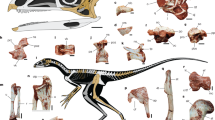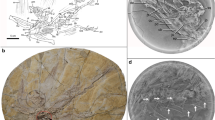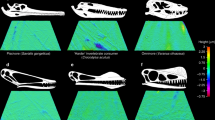A rare fossilized action snapshot captures a mortal tussle with a hungry predator.
Abstract
A remarkable specimen has been discovered of an Early Cretaceous pterosaur that has a tooth embedded in one of its cervical vertebrae: the tooth has been identified as one from a spinosaurid theropod dinosaur. This fossil is direct evidence that spinosaurs included items other than fish in their diet.
Similar content being viewed by others
Main
The diet of spinosaurid theropods such as Baryonyx and Spinosaurus has been the subject of speculation1,2,3. Their peculiar elongated jaws, sinuous tooth row and crocodile-like teeth suggest that they were piscivores, a habit supported by the discovery of Lepidotes scales etched by gastric juices within the body cavity of the type specimen of Baryonyx walkeri, from the Wealden of Britain1. However, bones of a juvenile Iguanodon were also associated with the specimen, suggesting that Baryonyx might not have been exclusively a fish-eater. Baryonyx may also have been a scavenger4. Still, until now there has been no direct evidence to indicate what the diet of other spinosaurs could have been.
The specimen we describe here (Fig. 1; Wyoming Dinosaur Center, WDC-SFB-001a,b,c), from the Early Cretaceous Santana Formation of northeastern Brazil, indicates that spinosaurs occasionally fed on pterosaurs, possibly during the course of scavenging activities. The specimen is part of a group of three pterosaur vertebrae enclosed in a nodule from the Romualdo Member of the Santana Formation5. The vertebrae are short and square-shaped in dorsal view, and are identified as cervical vertebrae6 numbers four to six of an ornithocheirid pterosaur, a family that occurs frequently in the Santana Formation7. Their size indicates that they belonged to a creature with a wingspan of about 3.30 metres.
a, Group of three cervical vertebrae (WDC-SFB-001a,b,c) of an ornithocheirid pterosaur from the Early Cretaceous Santana Formation of northeastern Brazil; right lateral view. The anteriormost vertebra is perforated by a spinosaur tooth. Scale bar: 20 mm. b, Close-up of pterosaur vertebra perforated by the spinosaur tooth, in dorsolateral view. Scale bar: 10 mm.
During the course of acid preparation of the nodule, we discovered that the anteriormost vertebra is perforated on the right side by a broken conical tooth (Fig. 1a). The tooth penetrates the vertebral centrum at the level of the anterior end of the pleurocoel, crosses the neural canal and damages the base of the neural arch, with its apex embedded in the left prezygapophysis (Fig. 1b). The thin, smooth enamel, straight crown, slightly compressed cross-section and lack of serrations on the lateral carinae show that the tooth is from a spinosaurid theropod.
Two spinosaurid taxa, Irritator challengeri and Angaturama limai, have been described from the Santana Formation3,8 (it is generally agreed that the latter is a junior synonym of the former). The tooth in the pterosaur vertebra is similar in every respect to the spinosaurid teeth previously described from the Santana Formation3,8.
The specimen is a rare instance of fossil ‘behaviour’: the tooth reached its present position when a spinosaurid bit into the neck of a pterosaur. As revealed by the presence of three associated cervical vertebrae, the neck must have been fresh and articulated when it was bitten; it was not swallowed and digested, because the vertebrae remain in articulation and lack evidence of etching by gastric juices. Despite their thin walls and hollow construction, the vertebrae must have been very resistant for the dinosaur tooth to break as it was biting them.
In what is the only previously known instance of dinosaur predation on a pterosaur — an azhdarchid tibia bitten by a troodontid from the Late Cretaceous of Alberta9 — a broken theropod tooth is similarly associated with a pterosaur bone. In the case described here, the pterosaur may have been caught on the wing or on the ground; although trackways reveal an unexpectedly high terrestrial velocity in some pterosaurs10, creatures with a large wingspan may have been vulnerable on the ground. But these options seem relatively unlikely and the scavenging of a pterosaur carcass on the shore of the lagoon in which the Santana Formation was deposited may be a more plausible explanation. Although the dinosaur did not swallow that part of the neck, this rare evidence of predation or scavenging shows that pterosaurs were part of the diet of spinosaurs, which we conclude were not strictly piscivorous.
References
Charig, A. J. & Milner, A. C. Bull. Nat. Hist. Mus. (Geol.) 53, 11–70 (1997).
Holz, T. R. Science 282, 1276–1277 (1998).
Sues, H. -D., Frey, E., Martill, D. M. & Scott, D. M. J. Vert. Paleontol. 22, 535–547 (2002).
Kitchener, A. Nature 325, 114 (1987).
Martill, D. M. Fossils of the Santana and Crato Formations, Brazil (Palaeontological Association, London, 1993).
Wellnhofer, P. Palaeontographica A215, 43–101 (1991).
Kellner, A. W. A. & Tomida, Y. Natl Sci. Mus. Monogr. 17, 1–135 (2000).
Kellner, A. W. A. & Campos, D. de A. Neues Jb. Geol. Palaeontol. Abh. 199, 151–166 (1996).
Currie, P. J. & Jacobsen, A. R. Can. J. Earth Sci. 32, 922–925 (1995).
Mazin, J. M., Billon-Bruyat, J. P., Hantzpergue, P. & Lafaurie, G. in Evolution and Palaeobiology of Pterosaurs (eds Buffetaut, E. & Mazin, J. M.) 283–296 (Geol. Soc. Lond. Spec. Publ. 217, London, 2003).
Author information
Authors and Affiliations
Corresponding author
Ethics declarations
Competing interests
The authors declare no competing financial interests.
Rights and permissions
About this article
Cite this article
Buffetaut, E., Martill, D. & Escuillié, F. Pterosaurs as part of a spinosaur diet. Nature 430, 33 (2004). https://doi.org/10.1038/430033a
Issue Date:
DOI: https://doi.org/10.1038/430033a
This article is cited by
-
110-million-years-old fossil suggests early parasitism in shrimps
Scientific Reports (2023)
-
Digital 3D models of theropods for approaching body-mass distribution and volume
Journal of Iberian Geology (2021)
-
Neuroanatomy of the spinosaurid Irritator challengeri (Dinosauria: Theropoda) indicates potential adaptations for piscivory
Scientific Reports (2020)
-
Niche Partitioning in Theropod Dinosaurs: Diet and Habitat Preference in Predators from the Uppermost Cedar Mountain Formation (Utah, U.S.A.)
Scientific Reports (2018)
-
Tooth loss and alveolar remodeling in Sinosaurus triassicus (Dinosauria: Theropoda) from the lower jurassic strata of the Lufeng Basin, China
Chinese Science Bulletin (2013)
Comments
By submitting a comment you agree to abide by our Terms and Community Guidelines. If you find something abusive or that does not comply with our terms or guidelines please flag it as inappropriate.




